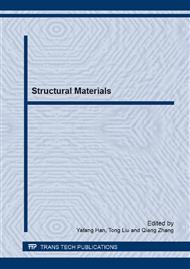[1]
A.C. Yeh, K. Kawagishi, H. Harada, T. Yokokawa, Y. Koizumi, T. Kobayashi, D.H. Ping, J. Fujioka, and T. Suzuki, Development of Si-bearing 4th generation Ni-base single crystal superalloys, Superalloys2008. 14-18 (2008) 619-628.
DOI: 10.7449/2008/superalloys_2008_619_628
Google Scholar
[2]
S. Ma, D. Brown, M.A.M. Bourke, M.R. Daymond, and B.S. Majumdar, Microstrain evolution during creep of a high volume fraction superalloy, Materials Science and Engineering A. 399 (2005) 141-153.
DOI: 10.1016/j.msea.2005.02.034
Google Scholar
[3]
C.M. Kuo, Y.T. Yang, H.Y. Bor, C.N. Wei, and C.C. Tai, Aging effects on the microstructure and creep behavior of Inconel 718 superalloy, Materials Science and Engineering A. 510 (2009) 289-294.
DOI: 10.1016/j.msea.2008.04.097
Google Scholar
[4]
M. Brunner, M. Bensch, R. Vӧlkl, E. Affeldt, and U. Glatzel, Thickness influence on creep properties for Ni-based superalloy M247LC SX, Materials Science and Engineering A. 550 (2012) 254-262.
DOI: 10.1016/j.msea.2012.04.067
Google Scholar
[5]
H.E. Huand, and C.H. Koo, Characteristics and mechanical properties of polycrystalline CM 247 LC superalloy casting, Materials Transactions. 2 (2004) 562-568.
DOI: 10.2320/matertrans.45.562
Google Scholar
[6]
A.C. Yeh, K.W. Lu, C.M. Kuo, H.Y. Bor, and C.N. Wei, Effect of serrated grain boundaries on the creep property of Inconel 718 superalloy, Materials Science and Engineering A. 530 (2011) 525-529.
DOI: 10.1016/j.msea.2011.10.014
Google Scholar
[7]
J.S. Van Sluytman, and T.M. Pollock, Optimal precipitate shapes in nickel-base γ-γ' alloys, Acta Materialia. 60 (2012) 1771-1783.
DOI: 10.1016/j.actamat.2011.12.008
Google Scholar
[8]
N. Bozzolo, N. Souaï, and R.E. Logé, Evolution of microstructure and twin density during thermomechanical processing in a γ-γ' nickel-based superalloy, Acta Materialia. 60 (2012) 5056-5066.
DOI: 10.1016/j.actamat.2012.06.028
Google Scholar
[9]
J.J. Moverare, S. Johansson, and R.C. Reed, Deformation and damage mechanisms during thermal-mechanical fatigue of a single-crytal superalloy, Acta Materialia. 57 (2009) 2266-2276.
DOI: 10.1016/j.actamat.2009.01.027
Google Scholar
[10]
J. Tiley, G.B. Viswanathan, J.Y. Hwang, A. Shiveley, and R. Banerjee, Evaluation of gamma prime volume fractions and lattice misfits in a nickel base superally using the external standard X-ray diffraction method, Materials Science and Engineering A. 528 (2010) 32-36.
DOI: 10.1016/j.msea.2010.07.036
Google Scholar
[11]
R.R. Unocic, N. Zhou, L. Kovarik, C. Shen, Y. Wang, and M.J. Mills, Dislocation decorrelation and relationship to deformation microtwins during creep of a γ' precipitate strengthened Ni-based superalloy, Acta Materialia. 59 (2011) 7325-7339.
DOI: 10.1016/j.actamat.2011.07.069
Google Scholar
[12]
N.E. Bagoury, and A. Nofal, Microstructure of an experimental Ni base superalloy under various casting conditions, Materials Science and Engineering A. 527 (2010) 7793-7800.
DOI: 10.1016/j.msea.2010.08.050
Google Scholar
[13]
G.M. Han, J.J. Yu, X.F. Sun, and Z.Q. Hu, Thermo-mechanical fatigue behavior of a single crystal nickel-based superalloy, Materials Science and Engineering A. 528 (2011) 6217-6224.
DOI: 10.1016/j.msea.2011.04.083
Google Scholar
[14]
T.M. Pollock, and S. Tin, Nickel-based superalloys for advanceced turbine engines: chemistry, microstructure, and properties, Journal of Propulsion and Power. 22 (2006) 361-374.
DOI: 10.2514/1.18239
Google Scholar
[15]
I.S. Kim, B.G. Choi, S.M. Seo, D.H. Kim, and C.Y. Jo, Influence of heat treatment on microstructure and tensile properties of conventionally cast and directionally solidified superalloy CM247LC, Materials Letters. 62 (2008) 1110-1113.
DOI: 10.1016/j.matlet.2007.07.058
Google Scholar
[16]
M.Z. Alam, D.V.V. Satyanarayana, D. Chatterjee, R. Sarkar, and D.K. Das, Effect of prior cyclic oxidation on the creep behavior of directionally solidified (DS) CM-247LC alloy, Materials Science and Engineering A. 536 (2012) 14-23.
DOI: 10.1016/j.msea.2011.10.016
Google Scholar
[17]
J. Coakley, and D. Dye, Lattice strain evolution in a high volume fraction polycrystal nickel superalloy, Scripta Materialia. 67 (2012) 435-438.
DOI: 10.1016/j.scriptamat.2012.05.015
Google Scholar
[18]
D. Leidermark, J.J. Moverare, S. Johansson, K. Simonsson, and S. Sjӧstrӧm, Tension/compression asymmetry of a single-crystal superalloy in virgin and degraded condition, Acta Materialia. 58 (2010), pp.4986-4997.
DOI: 10.1016/j.actamat.2010.05.032
Google Scholar
[19]
M.Hantcherli, F.P. Sturmel, B. Viguier, J. Douin, and A. Coujou, Evolution of interfacial dislocation network during anisothermal high-temperature creep of a nickel-based superalloy, Scripta Materialia. 66 (2012) 143-146.
DOI: 10.1016/j.scriptamat.2011.10.022
Google Scholar
[20]
ASTM E 139-06: Annual Book of ASTM Standards Vol. 3.01, (2006), pp.319-331.
Google Scholar


